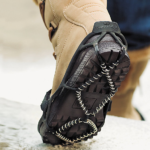Winter Hiking

We hike year round, and some of our favorite hiking takes place during the winter. Why? The trails are less crowded, and the wilderness often displays its most pristine beauty. There’s no better time to be outside than on a cold, crisp, achingly blue day with a fresh snow cover on the ground. And yes, if you dress properly, and you exercise some common sense, you can be utterly comfortable while you’re doing it.
Almost any trail in this guide can be hiked during the winter: many take on a particularly special, almost magical quality, though a few can be unpleasant. In general, except on windless days, you’ll want to avoid trails that run along exposed ridges. A winter wind can be chilling, whereas, within the forest canopy, there’s rarely more than a breath of wind (even on “windy” days). Hikes with scrambles also become more challenging, with handholds and footholds sometimes obscured by snow or ice.
Dealing with Mid-Hudson-Valley’s Winter Conditions
The mid-Hudson Valley is not the White Mountains or the Rockies, nor even the Adirondacks. Winter conditions here are usually milder here than in these classic winter hiking areas. It’s a rare winter’s day that you can’t go hiking somewhere in the area if you want. Some common sense, and a modest investment in proper clothing, will see you through.
Snow
Snow can be an issue, particularly at the higher elevations (especially above 2,000 feet). What will be “wintry mix” or rain in the valley may well be snow at altitude. Once there’s snow of more than 6″ or so on the ground, the difficulty of traversing ground will increase, and the more snow, the greater the challenge.
Does that mean you can’t go out? Not at all. On popular trails, even some of the more challenging ones, you’ll find that snow-shoers will pack down trails pretty quickly. Obviously, if you own a pair of snowshoes and are comfortable using them, have at it. However, if you don’t own them (and I’m one of those folks) it’s not necessarily disqualifying. After a day or two, you will probably be able to walk on top of a snowshoe-packed trail in reasonable comfort and with minimal “post-holing”.
My advice is to try it. There’s no shame in turning back if you’re not enjoying it. But you may be shocked at how lovely and relatively accessible these trails are with snow on the ground. Walking on packed snow will slow you down and will require a bit more effort: start with an beginner hike and then work your way up. And definitely bring those hiking poles… they’re essential in the snow.
Cold
Cold is actually rarely an issue hiking in the Hudson Valley. Generally novices OVERDRESS, so be warned: your body generates tremendous warmth when it’s walking, especially uphill. If you get a chill, it’s most likely (paradoxically) because you’ve been sweating.
The answer is to dress in layers, paying particular attention to having wicking underwear next to your skin. Avoid cotton clothing altogether, as it holds dampness next to your skin which is fine in the summer, but can be dangerous in winter. Personally, I usually wear ONLY a long sleeve undershirt, a thin, microfleece shirt, and a windproof shell down to about 20 degrees. Lightweight down jackets can also be useful, and are so breathable that they work well across a fairly wide range of temperature and work-rate.
Colder than 20°, I’ll add a second layer of microfleece, or swap out the microfleece for a single, heavier fleece. Do carry a pack and, of course, carry extra layers. Everyone is different, and my wife generally wears more layers than I do. Once you do it a few times, you’ll get the hang of it. As noted in the safety recommendations,on more remote hikes, I usually pack a heavy fleece layer and a mylar space blanket for emergencies.
When temps fall below 50°, a hat is essential. Since the rest of you will be covered, much of your body heat is lost through your uncovered head. But again, don’t overdress. A good pair of gloves or mittens are essential.
The final key to staying comfortable is to stay dry. As already mentioned, avoiding overheating/sweating is one key. But a snowy or muddy trail can get you wet. GoreTex pants and gaiters can keep snow or mud from slopping over the tops of your boots. You may also want to leave a change of dry shirt(s) in your car to change into when you get back to the trailhead. Even with the car heater on, driving home in damp clothing can be chilling.
Ice
Ice frequently builds up on trails after sustained snow cover because the compacted snow on the trails melts slowly. Thawing and freezing cycles over a series of days can turn the compacted snow to ice. Then you need something to give you extra traction. Beware any ice on an incline. Without traction aids you will slip.
These things don’t have to be elaborate or expensive: YakTrax cost less than $30/pair, and are light and compact in your pack. Definitely consider picking some up. Even if you only end up needing them once a season, you’ll be glad you have them.
Always watch out for ice whenever you walk in the cold. Most of the time you can walk around isolated patches, and you’ll find that even a relatively thin layer of fresh snow can provide decent traction to your lugged boots. But if you run into extensive ice that you can’t avoid, and don’t have traction aids with you, consider turning around.

